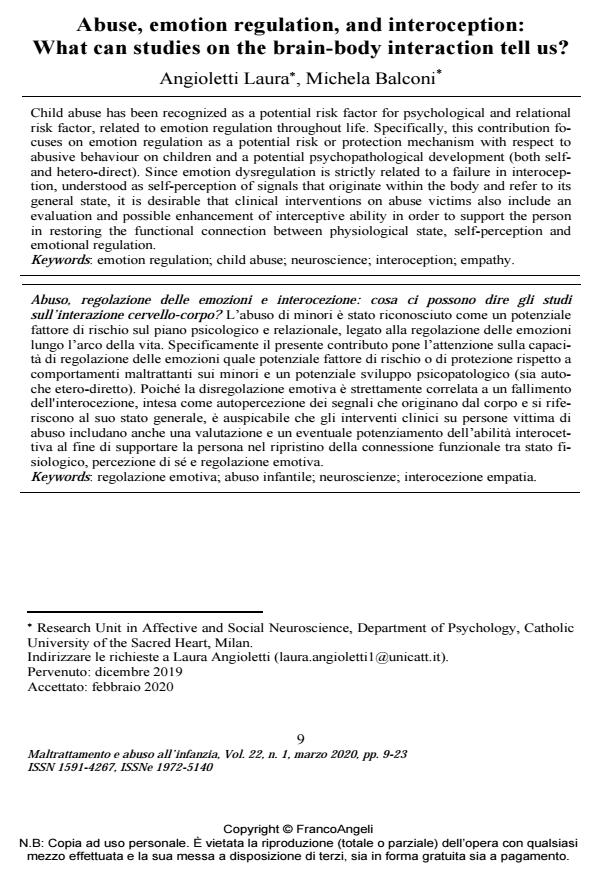Abuse, emotion regulation, and interoception: What can studies on the brain-body interaction tell us?
Titolo Rivista MALTRATTAMENTO E ABUSO ALL’INFANZIA
Autori/Curatori Laura Angioletti, Michela Balconi
Anno di pubblicazione 2020 Fascicolo 2020/1
Lingua Inglese Numero pagine 15 P. 9-23 Dimensione file 306 KB
DOI 10.3280/MAL2020-001002
Il DOI è il codice a barre della proprietà intellettuale: per saperne di più
clicca qui
Qui sotto puoi vedere in anteprima la prima pagina di questo articolo.
Se questo articolo ti interessa, lo puoi acquistare (e scaricare in formato pdf) seguendo le facili indicazioni per acquistare il download credit. Acquista Download Credits per scaricare questo Articolo in formato PDF

FrancoAngeli è membro della Publishers International Linking Association, Inc (PILA)associazione indipendente e non profit per facilitare (attraverso i servizi tecnologici implementati da CrossRef.org) l’accesso degli studiosi ai contenuti digitali nelle pubblicazioni professionali e scientifiche
Child abuse has been recognized as a potential risk factor for psychological and relational risk factor, related to emotion regulation throughout life. Specifically, this contribution focuses on emotion regulation as a potential risk or protection mechanism with respect to abusive behav-iour on children and a potential psychopathological development (both self- and hetero-direct). Since emotion dysregulation is strictly related to a failure in interoception, understood as self-perception of signals that originate within the body and refer to its general state, it is desirable that clinical interventions on abuse victims also include an evaluation and possible enhancement of interceptive ability in order to support the person in restoring the functional connection between physiological state, self-perception and emotional regulation.
L’abuso di minori è stato riconosciuto come un potenziale fattore di rischio sul piano psicolo-gico e relazionale, legato alla regolazione delle emozioni lungo l’arco della vita. Specificamen-te il presente contributo pone l’attenzione sulla capacità di regolazione delle emozioni quale potenziale fattore di rischio o di protezione rispetto a comportamenti maltrattanti sui minori e un potenziale sviluppo psicopatologico (sia auto- che etero-diretto). Poiché la disregolazione emotiva è strettamente correlata a un fallimento dell'interocezione, intesa come autopercezione dei segnali che originano dal corpo e si riferiscono al suo stato generale, è auspicabile che gli interventi clinici su persone vittima di abuso includano anche una valutazione e un eventuale potenziamento dell’abilità interocettiva al fine di supportare la persona nel ripristino della connessione funzionale tra stato fisiologico, percezione di sé e regolazione emotiva.
Parole chiave:Regolazione emotiva; abuso infantile; neuroscienze; interocezione empatia.
Laura Angioletti, Michela Balconi, Abuse, emotion regulation, and interoception: What can studies on the brain-body interaction tell us? in "MALTRATTAMENTO E ABUSO ALL’INFANZIA" 1/2020, pp 9-23, DOI: 10.3280/MAL2020-001002